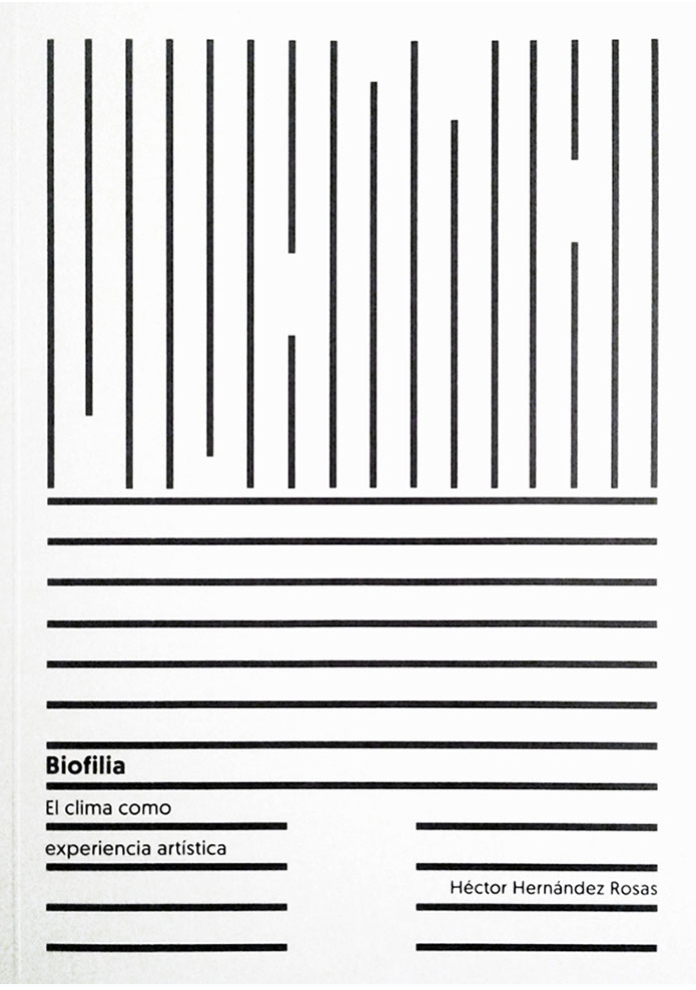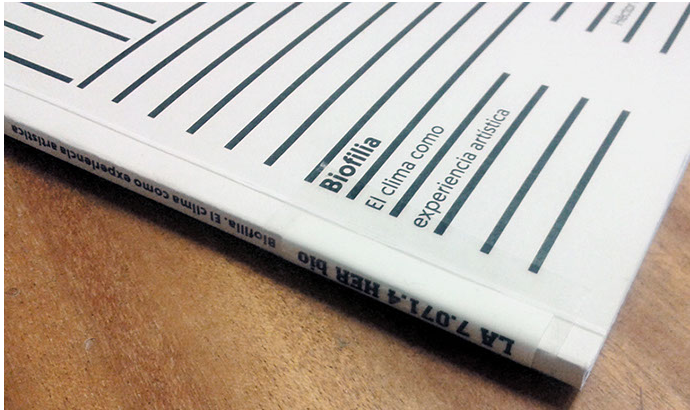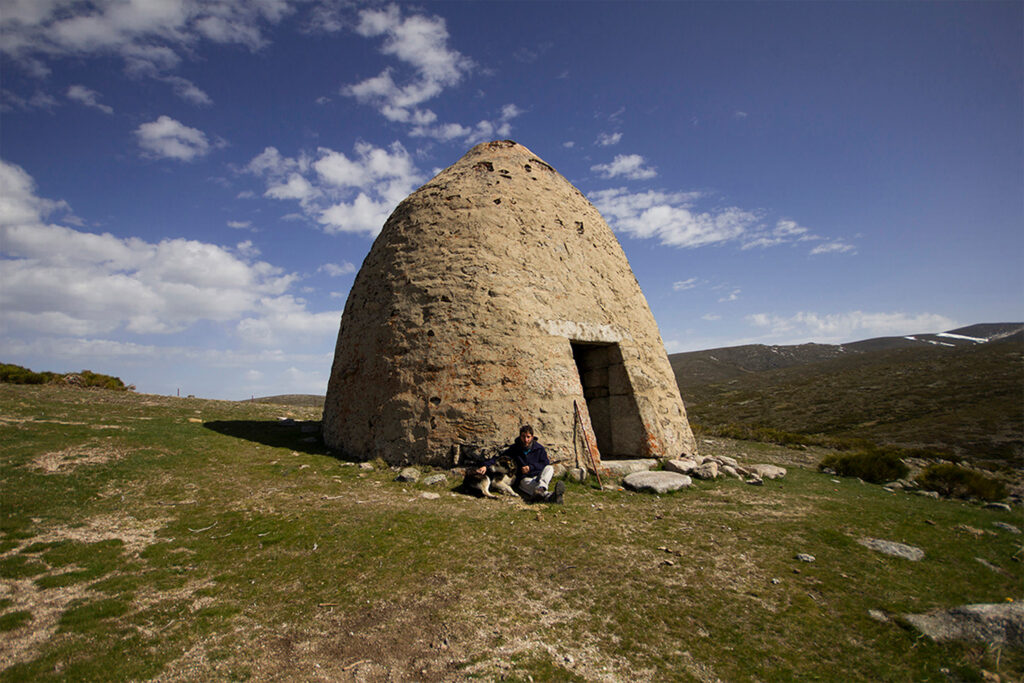Biofilia

La cabaña como puente. Fotografía a color

La presencia de lo infinito. 7 fotografías a color con texto.
Luz silenciosa I, II, III y IV. Fotografía a color
Pulso de la Tierra. Instalación, troncos, pantalla y altavoz.
Biofilia. El clima como experiencia artística.
Edición publicada por la Sección Departamental de Historia del Arte III (contemporánea) de la UCM.
Hernández, H. Biofilia. El clima como experiencia artística.
ISBN: 978-84-617-6271-2. Madrid: Palabras de imágenes


Descripción del proyecto
“La gente de la ciudad a veces se asombra de que uno permanezca arriba en la montaña entre campesinos durante periodos de tiempo tan largos y monótonos. Pero no es aislamiento, es soledad… La soledad tiene el peculiar y original poder de no aislarnos sino de proyectar toda nuestra existencia hacia fuera, hacia la vasta proximidad de la presencia de todas las cosas.” Martin Heidegger
El concepto de Biofilia ha sido definido, por un lado, desde el punto de vista psicológico y moral por Erich Fromm como un modo de ser manifestado en los gestos, en los procesos corporales de una persona, que es atraída por el crecimiento en todas las esferas, goza de la vida y de todas sus manifestaciones.
Por otro lado, la hipótesis de la biofilia, introducida por el biólogo Edward O. Wilson en su libro Biofilia y desarrollada junto a Stephen R. Kellert en The biophilia hypothesis, define la biofilia como la afinidad innata por todo lo viviente, la necesidad de afiliarse con otras formas de vida, el sentido de conexión con la naturaleza y la vinculación emocional con otros sistemas vivos, con el hábitat y con el entorno.
Este proyecto “Biofilia” se centra en la desvinculación del ser humano con la naturaleza, en la relación con su entorno y en el déficit de conocimiento, de contacto y de experiencia que tenemos del territorio.
Partiendo de la experiencia vital en el territorio y, enfocada específicamente en los factores ambientales y climáticos, inicié este proyecto yendo cuatro días al Chozo Blanco, una cabaña de pastores a 1800m. de altitud en la cara norte de Gredos, accediendo a ella tras una ruta a pie de unas 3 horas.

La cabaña como puente
15 fotografías fueron tomadas durante un día desde el interior de la cabaña y 15 durante otro día desde el interior del puente del pueblo cercano a la cabaña, revelando el movimiento de la luz a lo largo de un día.
En ambos lugares, el chozo y el puente, el interior es oscuro, construidos con piedra, con un marco rectangular, donde solo vemos el suelo y la luz del paisaje de fuera.
El puente se llama “el puente de los siete ojos”. Un ojo es el espacio entre dos estribos o pilas de un puente, por donde fluye el agua. La cabaña, no tiene puerta, está abierta, y perfectamente orientada al movimiento del sol en invierno, de la luz.
Estos paralelismos (cabaña y puente, puerta y ojo, luz y agua) me llevan al mismo punto, al movimiento.La cabaña como puente, como forma de tránsito.
Muchos han pasado por la experiencia de vivir en una cabaña, desde pastores, agricultores y leñadores hasta pensadores, escritores y artistas. Tanto para refugiarse de la naturaleza como para refugiarse en la naturaleza, para huir de las ciudades y de la sociedad y de uno mismo, como para buscarse a uno mismo, como acto de valor y liberación o como acto de desapego o como acto de rechazo, para pensar y recogerse intelectualmente o para hacer frente solo a los hechos esenciales de la vida. Desde Thoreau, Heidegger, Virginia Woolf, George Bernard Shaw, Lawrence de Arabia, Gustav Mahler y Masanobu Fukuoka hasta Arne Naess, Theodore Kaczynski y Christopher McCandless.
Puede llevarnos al imaginario colectivo de naturaleza idílica, incontaminada, o puede llevarnos a deshabitarla e incluso a destruirla como hizo Robert Smithson en Partially Buried Woodshed.
Por tanto no propongo la cabaña como mensaje.
Ni como retiro, ni como alejamiento, ni como aislamiento.
Ni como utopía idílica, ni como mito al que matar.
Ni como verdad.
En esa distancia al paisaje externo, en ese déficit de contacto del territorio, de ese paisaje que no logramos alcanzar, se ofrece la cabaña (la oscuridad de su interior, de nosotros mismos, de nuestra falta de experiencia y de recursos) tan sólo como experiencia. Una experiencia de movimiento que nos lleva un paso más allá desde el punto que nos encontramos, como acercamiento y tránsito a la vasta proximidad de la presencia de todas las cosas.

La presencia de lo infinito
“Tal vez los hechos más sorprendentes y más reales nunca se hayan comunicado […] Es algo tan intangible e indescriptible como los matices de la mañana o de la tarde” H.D. Thoreau.
Esta serie de montajes fotográficos no son panorámicas de 360º que recogen un instante de lo que ocurre, sino de fotografías tomadas en un rango de varias horas de y desde distintos lugares, uniendo así lo que ocurre en un amplio margen de tiempo.
En mi intento de hablar de las sensaciones que genera el clima, el ambiente y el paisaje y de transmitir esa vivencia, consigo únicamente suplantarlas a través de una mediación tecnológica obteniendo nada más que una minúscula reverberación.
No sentimos la luz, ni olemos el aroma matinal ni la tierra mojada, la humedad y el frío no entra por nuestros poros, el viento no nos arrastra y no conseguimos ser uno con el paisaje.
Me encuentro con la incapacidad, con ese disgusto con la palabra, con el lenguaje y con la capacidad intelectual que relata Lord Chandos en su carta porque no puede penetrar en el interior de las cosas.
Irónicamente escribe su última carta, para decir que no va a volver a escribir, utiliza la palabra para decir que ésta es incapaz de expresar nada y para expresar ese estado del que dice es incapaz de hablar.
Y yo me encuentro en la misma situación. Por ello, como en la carta, propongo estos montajes fotográficos con la misma contradicción. Quiero que esa falta de experiencia y esa incapacidad para sentir aquello que se ofrece sea evidente, señalando que hay algo que se nos escapa, la experiencia. Las sensaciones no visuales a las que hacen referencia pretenden potenciar aquello que no podemos obtener a través de la imagen, aquello que no podemos asir.
Luz silenciosa
“No era solo un lugar, era toda una experiencia que sobretodo en el caso de Anselm (Adams), tenía que ver con el tiempo, el momento, con ese algo evanescente que desaparecía.”
Las siguientes fotografías muestran momentos efímeros, sutiles y poéticos en los que la luz, en unos intervalos de tiempo, se mece junto con el territorio.
Unos intervalos de tiempo en que la mente no permite pensar en nada que no corresponda al momento y al lugar.
Un tiempo suspendido en el que hay una disposición interna a percibir el mundo y la existencia que nos rodea donde la distancia con el entorno desaparece, un momento de vinculación íntima en el que la vida penetra por todos los sentidos, en el que nos movemos con la luz, con el viento, con la temperatura.
Un intervalo silencioso en el que somos la unión de cielo y tierra, somos paisaje.
Pulso de la Tierra
“La tierra lo sabe” me dijo un anciano. “Si le haces daño, toda la tierra lo sabe. Ella siente lo que le está sucediendo. Yo creo que todo está conectado entre sí de alguna manera, bajo la tierra.” Richard Nelson
La instalación está formada por tres columnas de secciones de troncos que disminuyen su tamaño a medida que ascienden, con el interior vacío y quemado. Un negro de las profundidades de la tierra, donde el espectador puede agarrarse e introducir su mirada y su atención hacia el fondo, al interior del árbol, de la tierra.
El tacto del árbol, el olor a madera quemada y la oscuridad de su interior se mezclan en el fondo, en un caso con un audio y en otro con un vídeo. La tercera columna de troncos está vacía.
Partiendo del sonido de un terremoto de 4.9 grados que ocurrió en El Hierro y de la antigua teoría de Pitágoras de la Armonía de las Esferas en la que los planetas se regían según proporciones musicales y emitían sonidos al describir sus órbitas y que -producido en el espacio por las vibraciones de la interacción del viento solar con la ionosfera de cada uno de los planetas- la NASA, con el equipo especializado Voyager-1 y 2, junto al Dr. Jeffrey Thompson, han conseguido grabar, se ha realizado una pieza sonora y otra fílmica para metaforizar esa idea de unión entre el espacio interior del planeta con el espacio externo.
De esta forma, la instalación crea a través del interior del árbol un espacio de canalización a la vez ascendente y descendente que envuelve en la oscuridad del interior de la tierra, en un tiempo profundo donde asomarse es asomarse a la quietud del tiempo.
Biophilia. The climate as an artistic experience.
Edition published by the Departmental Section of History of Art III (contemporary) of the UCM.
Hernández, H. Biophilia. The climate as an artistic experience. ISBN: 978-84-617-6271-2. Madrid: Palabras de imágenes
Download here

Project description
“People in the city often wonder whether one gets lonely up in the mountains among the peasant for such long and monotonous periods of time. But it is not loneliness, it is solitude. Solitude has the peculiar and original power not of isolating us but of projecting our whole existence out into the vast nearness of the presence of all things” Martin Heidegger
The concept of biophilia has been defined on the one hand from a psychologically and morally point of view by Erich Fromm, as a way of being expressed in gestures, in the bodily processes of a person who is attracted by growth in all areas, enjoys life and all its manifestations.
On the other hand, the biophilia hypothesis, introduced by the biologist Edward O. Wilson in his book Biophilia and developed together with Stephen R. Kellert in The biophilia hypothesis, defines biophilia as the innate affinity for all living things, the urge to affiliate with other forms of life, the sense of connection with nature and the emotional bonding with other live systems, with the habitat and the environment.
This project, «Biophilia» focuses on the separation of human with nature, on the relationship with his environment and the lack of knowledge, contact and experience we have of the territory.
Focusing on how we relate to the landscape and, more specifically with environmental and climatic factors, I began this project going for four days to the “Chozo Blanco” a shepherd’s hut at 1800m. of altitude on the north side of Gredos, accessing after a walking of 3 hours.
The hut as a bridge
15 photographs were taken during a day from inside the hut and the others 15 photographs were taken during another day from inside the bridge of the village near the hut, revealing the movement of the light along one day.
In both places, the hut and the bridge, the inside is dark, built with stone with a rectangular frame where we can only see the floor and the outside landscape light.
The bridge is called “the bridge of the seven eyes”. An eye is the space in-between two buttresses of a bridge, where the water flows by. The hut has no door, it is open and perfectly oriented to the movement of the winter sun, to the light.
These parallelisms (hut and bridge, door and eye, light and water) lead me to the same point, the movement.
The hut as a bridge, the hut like as a way of transit.
Many have had the experience of living in a hut, from shepherds, farmers and lumbermans to thinkers, writers and artists.
Both as to refuge from nature as to refuge in nature, to escape from de cities and society and oneself as to find oneself, as a courage and liberation act or as a detachment act or as a repulse act, to think and isolate intellectually or to deal only the essentials facts of life.
From Thoreau, Heidegger, Virginia Woolf, George Bernard Shaw, Lawrence de Arabia, Gustav Mahler and Masanobu Fukuoka to Arne Naess, Theodore Kaczynski and Christopher McCandless.
It can take us to the collective imaginary of idyllic nature, uncontaminated or it can lead us to leave it and even to destroy it as Robert Smithson in Partially Buried Woodshed did.
Therefore, I do not propose the hut as a message.
Nor as retreat nor as remoteness nor as insulation.
Nor as an idyllic utopia nor as a myth to kill.
Nor as truth.
In that distance with the external landscape, with that deficit of contact of the territory, of that landscape we can not reach, the hut (the darkness inside it, inside of ourselves, of our lack of experience and resources) is offered just as experience. An experience of movement that leads us one step further from the point where we are, as an approach and transit to the vast nearness of the presence of all things.
The presence of the infinite
“Perhaps the facts most astounding and most real are never communicated by man to man. The true harvest of my daily life is somewhat as intangible and indescribable as the tints of morning or evening” H.D. Thoreau
This series of photomontages are not 360 degrees panoramic collecting a moment what happens, but photographs taken over a range of several hours to and from different places, thus linking what happens in a wide range of time.
In my attempt to talk about the feelings generated by the climate, the environment and the landscape and to transmit this experience, I only supplant them through a technological mediation getting nothing but a tiny reverberation.
We don´t feel the light or the morning scent or the wet soil, the moisture and cold don´t enter by our pores and the wind does not get dragged us. We can´t become one with the landscape.
I find myself with the inability of the artwork to give us that experience, to give us that contact, to make us feel that climate. It’s that dislike with the word, the language and the intellectual capacity that Lord Chandos describes in his letter because it can not penetrate the interior of things.
Ironically he wrote his last letter to say he is not going to write again, he uses the word to say that words are unable to express anything and to express that state he says is unable to speak.
And I find myself in the same situation. Therefore, as in the letter, I propose these photographic montages with the same contradiction. I want that inexperience and inability to feel that what is offered is obvious, so there is something to be noted that escapes us, to mark the extinction of experience.
The non-visual sensations that the titles refer aim to promote what we can not get through the image that we can not grasp.
Silent light
«It was not just a place, it was an experience that especially in the case of Anselm (Adams) had to do with time, the moment, with that evanescent something disappearing»
The following series of photographs show ephemeral, subtle and poetic moments where the light, in some time intervals, sways together with the territory.
Time intervals in which the mind can not think of anything that does not correspond to the time and place.
A suspended time in which there is an inner disposition to perceive the world and the existence around us where the distance with the environment disappears, a moment of intimacy in which life penetrates every way in which we move with light, with the wind, with the temperature.
A silent interval in which we are the link between the sky and earth, we are landscape.
Earth pulse
«The earth knows it,» said an old man. «If you hurt her, all the earthknows. She feels what’s happening. I think that everythingis connected together somehow under the ground.» Richard Nelson
The installation is composed by three columns of trunks which get smaller as they ascend on an empty and burned inside. A black from the depths of the earth, where the viewers can grab and put their eyes and their attention to the bottom, inside the tree, inside the earth.
The touch the tree, the smell of burning wood and dark from inside mix in the bottom in one case with an audio and in the other case with a video, the third trunks column is empty.
Based on the sound of an earthquake of 4.9 degrees that took place in El Hierro and the old Pythagorean theory of the Harmony of the Spheres in which the planets were governed by musical proportions and emit sounds when describing their orbits and – produced by the interaction of the solar wind with the ionosphere of each of the planets- the NASA and Dr. Jeffrey Thompson, with specialized equipment Voyager-1 and 2 have managed to record, a sound and a filmic piece has been realised to do a metaphor of that idea about linking the internal space of the planet with the outer space.
In this way, the installation creates through the emptied trees a channelling space, at the same time ascending and descending, that shroud us in the darkness inside the earth, in a deep time where looking into is looking into the stillness time.





























